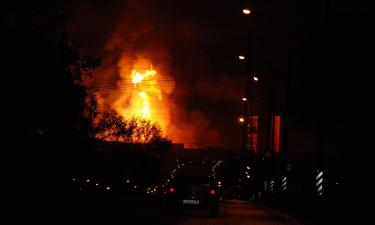Insurgency - 101, Misunderstood
No population of any country, in the absence of assured protection of life, home, and tradition will support the actions of a non-regional force, while that external force is fighting an insurgency within the sovereign borders of their country.
With that said, one can conclude that this is why American forces have lost the support of the Iraqi population and will likely never be able to regain it.
The U.S. has failed to free the population of Iraq from the intimidating influence of insurgents. Short of calling on the off again/on again use of heavy weaponry, which brings the resultant collateral damage to include the deaths and injuries of scores of people, the population is not convinced.
Arguably, these heavy offensive military actions against the insurgent force are necessary, and justified, to meet and defeat the armed threat. They are, nonetheless, counterproductive toward the establishment of the end-state which should not be a body-count of enemy fighters but rather the collective public opinion of the Iraqi population.
Regardless of the force ratio mix of indigenous, or externally sympathetic guerrillas, all insurgencies must have the population's support to assure their survival. The insurgent force must be denied refuge and assistance. The potential pool of recruits, to include the casual use of children as tentacles of the effort against Western forces, must eliminated from the sustaining equation of the resistance.
Sadly, strategic and tactical military planners from U. S., and coalition forces, have not adequately shifted their military operational planning. The focus toward a counterinsurgency strategy, in which pacification of the civilian population is given the priority, is now too late!
The narrow window of opportunity, to garner indigenous support, passed while the U.S. pursued its myopic strategic goal of finding, apprehending, or killing Saddam Hussein.
The primary actions, in countering the burgeoning insurgency in Iraq, should have been directed at securing and protecting the grass-roots population. The main effort should not have been hunting down illusive and spectral insurgents. Their capture, largely symbolic and agreeably not insignificant, should have been ancillary to the big picture.
At this point of mission execution, as history will record, the U. S. and its coalition partners must realize and accept that the current uprising in Iraq can only be overcome, and ultimately defeated by, Iraqi forces under Iraqi leadership. The more rapidly these forces can bifurcate themselves from the non-regional U. S. force, and seriously reduce their reliance on U. S. involvement, the sooner the problem will be solved.
Military objectives hold obvious and often exigent importance in Iraq, quite simply, when someone is shooting at you, your actions must be event driven. This, a basic military tenet!
However, it is also most important to assure the close and tacit assimilation of both civil and military actions and efforts.
Neither can be prosecuted in spite of each other, there must be a carefully coordinated and planned collaboration. The preponderance of effort must be dedicated to achieving confidence building political objectives instead of achieving simple conventional military goals of killing the enemy and seizing the terrain he once held.
This typifies both the asymmetric nature of the threat that challenges U. S. forces, particularly the need to earn, gain, and maintain both American and Iraqi public support for the war.
The erosion of America's national will led to its embarrassing evacuation from Vietnam in 1975. The end-state, declared by the U. S. after concluding that its too-little and too-late attempts at Vietnamization failed can only beseenfor what it was. That, being the sacrifice of an entire American army in the dank jungles, paddies, and hillsides of Vietnam.
Today, however, the clear and present threat which faces the American soldiers on the battlefield in Iraq, dictates that the national will and war support among the Iraqi population, is of a greater priority then that of domestic support for America’s non-domestic military actions.
Yet, even more complicated in Iraq, is the fact that the on-going and rising insurgency has a distinct absence of unity of command and battlefield continuity. This insurgency, as it has increasingly emboldened itself, has honed its skill at idiosyncratic asymmetric warfare which is characterized by its unorthodox approach or means of applying its capabilities.
This is a doctrine, either planned, de-facto, or by happenstance that does not follow the rules, and is peculiar in a sinister sense. It is close to impossible to plan for and counter as many targets hold virtually no military or force-related significance.
This style of insurgency and warfare was well analyzed by U. S. General Montgomery C. Meigs in 2003, appearing in “Parameters”, journal.
https://www.comw.org/rma/fulltext/0306meigs.pdf
As such, the conventional military planner who seeks to establish operational conclusions and thus develop military deployment options, on known or relatively certain paradigms is hamstrung.
Much of the resultant confusion is largely because of lack of precedent. Similarities between the insurgency in Iraq and those of the Communist and Nationalist insurgencies of the Cold War, are totally absent. Relying on after action reports and historic mission analysis could proved to be a deadly mistake on the battlefield of today.
A more complicated a challenge in this particular insurgency in Iraq is a factor that collectively unites many, “otherwise conflicted”, factions.
Muslim fundamentalist Mujahideen, Shiite Extremists, and Baathist Remnants, as well, the large majority of the Iraqi people, are united in their overwhelming desire to drive the culturally ignorant American forces out of their country and the region overall.
If Washington can rapidly diminish its involvement in Iraq, in all quarters, it is likely that the collective bond and rallying-cry of the insurgency will falter in influence and substance.
Make no mistake, this will not be accomplished by merely conducting a free-appearing election on Jan. 30th. there is more that must be done!
The Iraqi government must capitalize on the long-standing divisions between the insurgent factions and their established historic loyalties.
Legitimization of some factions in Iraq, and the careful effort of bringing them to the table and into the political mainstream within Iraqi circles, would then separate the most violent insurgent cells. The goal being to force them into less effective compartmentalized factions.
This effort will restrict the ability of the insurgent force to destabilize, strike fear, and influence the population. Inducements to fracture the insurgency further should include a promise of amnesty to those who are serious about their future role in the governance of Iraq.
It is critically important that the Iraqi national elections be held with all available integrity in the coming days. Iraq must take control of Iraq and the will of the population must prevail.
J. David Galland
J. David Galland is former U. S. Army Case Officer, Intelligence School Instructor, and The Deputy Editor of DefenseWatch Magazine. He can be reached at JDavidGalland@military.com and JDavidGalland@yahoo.com
Subscribe to Pravda.Ru Telegram channel, Facebook, RSS!



